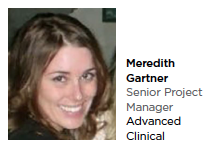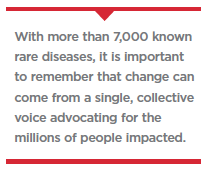Next-generation technologies in medicine have opened new doors for identifying rare diseases and developing better and more targeted rare disease treatments. Remarkable advancements in global research efforts have already made an impact on the lives of patients living with hundreds of rare disease types, especially due to the  recent exponential growth in approved treatment options since 2010. Now, as the industry embarks on a new stage of research in gene therapy and precision medicine, it is important to recognize the forces that brought initial change, so that improvements continue to extend beyond the limits of what is possible for patients today.
recent exponential growth in approved treatment options since 2010. Now, as the industry embarks on a new stage of research in gene therapy and precision medicine, it is important to recognize the forces that brought initial change, so that improvements continue to extend beyond the limits of what is possible for patients today.
In 1983, when the Orphan Drug Act was signed into law, there were 16 orphan drug designation requests. In 2015, there were 472 requests. That growth is attributable to many factors, but perhaps most importantly, the powerful impact of advocacy. When patients and families, patient organizations, clinical development organizations, clinicians, and researchers joined to create one voice calling for improved rare disease treatment options, the result had a meaningful impact.
The momentum created by that collective voice remains evident. The means by which rare and genetic diseases are diagnosed is on track to improve with genotype–phenotype correlation and novel gene discovery. However, most patients with rare diseases are spending years in the healthcare system undiagnosed. There has been exceptional growth in research capabilities, but the vast majority of patients living with rare diseases are still in need of an early and accurate diagnosis, access to newly available treatments, and quality and quantity of life improvements.
As research efforts continue to drive new treatment options, the environment for patients can be further improved using the same approach that first brought change: to collectively solve challenges with the spirit of patient advocacy. Clinical trial teams, working together with all relevant stakeholders, play a vital role in this by:
Expanding the reach of trials and potential treatment options to new clinical sites
Educating healthcare practitioners and patient communities about clinical research participation
Connecting patients to sites, sites to patients, and patients to patients through traditional grassroots outreach and new digital platforms
Sharing transparent trial progress information with participants
Finish Rare Disease Trials Strong by Starting Strong
Some of the differences between rare disease trials and other types of research studies  are found in the site selection approach, level of protocol complexity, and extended durations between study visits. It is important for clinical research teams to consider these factors and make adjustments at the start of a rare disease trial. Ensure a strong start by unifying stakeholders, offering sufficient support tools, and creating a platform to share successes along the way:
are found in the site selection approach, level of protocol complexity, and extended durations between study visits. It is important for clinical research teams to consider these factors and make adjustments at the start of a rare disease trial. Ensure a strong start by unifying stakeholders, offering sufficient support tools, and creating a platform to share successes along the way:
1. Unify Stakeholders. In rare disease studies, the site selection process is different in that it is patients that need to be identified versus primary investigators. Rare disease research-experienced sites typically have strong, active relationships with Sponsors due to the rare nature of the diseases. The key is bringing all stakeholders to the table – patients, caretakers, sites, KOLs, CRO’s/vendors, and the Sponsor.
2. Offer Support Tools. Another key consideration is that because enrollment for rare disease studies may be very slow, there are usually long gaps between screening visits. Equipping sites with support materials is especially helpful for these trials, so that PI’s and study coordinators can easily access tools that help refresh critical protocol information, like inclusion/exclusion criteria. From a patient perspective, many of those with rare diseases have experienced difficulty finding the right care due to lack of treatment options. For that reason, they may be skeptical towards new healthcare providers, so helping patients establish a trusting relationship with PI’s is critical for maintaining engagement throughout a trial. Support tools can enable clear communication pathways that help patients feel supported and engaged.
3. Share Successes. On top of these considerations, it is incredibly beneficial to provide opportunities for sites to communicate and share successes. Getting the community of study coordinators together via webinars or face-to-face meetings to exchange ideas is highly impactful and motivates the sites. Continual collaboration between rare disease research sites is important.
With more than 7,000 known rare diseases, it is important to remember that change can come from a single, collective voice advocating for the millions of people impacted. The research process is long, and the challenges associated with rare disease research in particular can be frustrating, but by strengthening our voice as clinical researchers and consistently delivering results, a better quality of life for patients living with rare diseases is in reach.(PV)
Advanced Clinical is a global clinical development organization that provides CRO, FSP, Strategic Resourcing, and Consulting Services for biopharmaceutical and medical device organizations.
To learn more, visit www.advancedclinical.com.
With more than 7,000 known rare diseases, it is important to remember that change can come from a single, collective voice advocating for the millions of people impacted.
















